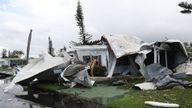Hurricane Irma v Hurricane Andrew
A quarter of a century ago, Hurricane Andrew left a trail of destruction across Florida, but Irma threatens to be much worse.
Saturday 9 September 2017 14:50, UK
Irma has developed into a very powerful hurricane and has wreaked devastation as it swings towards the US.
Evacuation orders have been- more than a quarter of the state's population.
For many residents it will bring back memories of Hurricane Andrew in 1992.
At the time, it was the most destructive hurricane to ever strike the US, causing up to $32bn of damage in the day's valuation of the dollar and killing 65 people.
Irma is already much larger than Andrew, swelling to more than 800 miles across and as big as a hurricane can physically get.
::
An image comparing the two hurricanes by Twitter user Joel Nihlean shows the seemingly diminutive Andrew digitally superimposed ahead of Irma.
The differences between the two are not just a matter of size, however.
While both Andrew and Irma had similar origins as tropical waves moving off of the African coast, their routes over Florida are likely to be very different.
Andrew mainly affected the southern third of the Florida peninsula, travelling quickly from east to west.
Irma is expected to travel right up the spine of Florida, lasting much longer than Andrew and bringing with it enormous storm surges of water leading to coastal flooding.
NASA data has shown sea surface temperatures of above 30C, capable of sustaining the powerful hurricane.
Andrew's storm surge reached 17ft in height at one point, but in 1992 the areas it hit were not as densely populated as they are today.
Jim Kossin, an atmospheric scientist with the US National Oceanic and Atmospheric Administration, told Wired: "Irma is anomalous. This is a record-breaker. Unprecedented. Catastrophic."
Although it will not hit Florida, another large hurricane - Jose - is following Irma. Andrew was the most significant storm of that year.
Irma herself is following Harvey, the sheer weight of the rain from which caused .
Jose is not far behind Irma and is expected to strengthen to a category five hurricane with winds of more than 157 mph.




